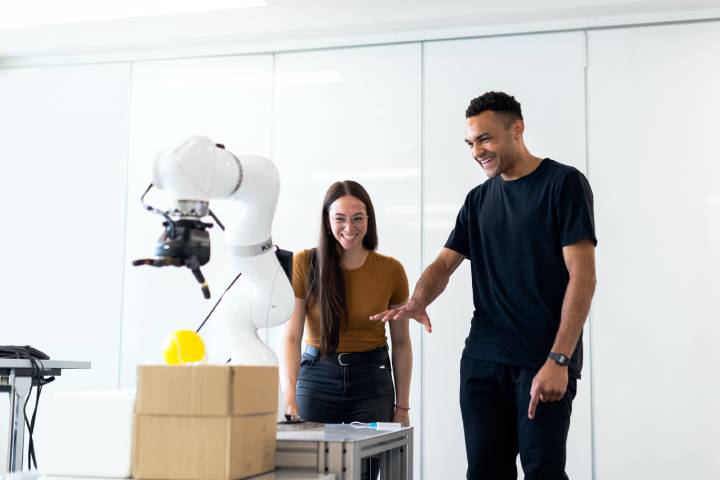In one of its latest updates, one of the leading RPA manufacturers highlighted the incorporation of Artificial Intelligence into its software robots. But what can AI bring to this technology? In which specific use cases can it be applied? In this article, we answer these two questions. Read on and discover the future that has already arrived.
Software robots are not a new tool, although there are still many companies who do not know or know the potential that can have. Both the evolution of the market and the new behavior of consumers and users, directed towards a clear digital trend, have boosted the digital transformation in organizations.
This has caused us to find ourselves in the ideal scenario to continue investing in new business solutions, in addition to directing the strategy to the search for an optimization of the processes that take place in an organization.
Artificial Intelligence is a concept that can be applied to different tools, to provide them with greater functionality as well as to enhance their capacity in certain respects, as in making decisions autonomously.
We must discard the idea of a robot (whether physical or software) with intelligence that “turns” against the human, a thought that can be disturbing.
The true value of AI in any type of software, such as RPA, is that it can perform more complex and evolved automation without the need for human interference.
Table of Contents
So what can Artificial Intelligence bring to RPA technology?
What we know so far about software robots is that they are capable of performing certain repetitive and tedious tasks, reducing the margin for errors, and freeing the employee to dedicate their time to other activities of greater value. This is the essence of the definition.
Now we introduce the AI variable. The tasks that were already automated are still so, but now, these softbots are capable of making predictions, learning, and evolving with the new variables that are emerging.
Thus, for example, in the event of a computer attack, the RPA robot is capable of detecting it, blocking it, and “learning” for future cyberattacks. Thus, even if the type of threat changes, RPA is able to know that it is facing one, and neutralize it.
Another example is when managing data from various sources. In general terms, the softbot can be predetermined and programmed to “read” and archive the information according to the source, format, etc.
With AI, in addition, faced with a different format, the software robot is able to process it, based on the experience it has had so far.
RPA and Artificial Intelligence: the perfect technological tandem
The incorporation of this type of technology in companies tends to bring a lot of uncertainty, especially due to the fear that it may supplant the tasks performed by an employee. The templates are suspicious that tools are implemented that jeopardize daily work.
However, nothing is further from the truth, since RPA software robots with AI do not eliminate jobs, but complement the work of workers, taking care of those tasks that, although necessary, add little value to the business (checking bank accounts, incorporating information into the ERP, checking emails, filing data, etc).
Once you have RPA in place, your company will be able to:
- Stop doing repetitive and tedious processes.
- Eliminate errors, or minimize them.
- Dedicate time to more valuable areas: customer service, creativity, design, analysis, etc.
- Have more satisfied employees in their work position, as well as enhance talent.
In addition to the benefits, the best way to explain a technology is by showing its application. And so, we link to the second question that we raised at the beginning of this article: In what specific use cases can RPA with AI be applied?
Document management: PLN-based RPA solution
The organization of documentation is one of the most recurrent tasks in companies, and also one of the heaviest. In some organizations, each department has personnel assigned exclusively for this task, and in other smaller organizations, it is the employees themselves who dedicate part of their day to carrying out this activity.
The RPA software robot, together with PLN (Natural Language Processing) technology, is capable of receiving information and classifying it automatically.
PLN is a mechanism within Artificial Intelligence that is capable of formulating an understandable language between machines and humans. Thanks to certain programs that simulate communication, this tool helps softbots to process documents in the most efficient way possible. In addition, with the functionalities provided by AI, the solution learns the variations effectively.
Manage contracts and invoices: from email to ERP
Numerous documents usually arrive in the email inbox, from contracts, supplier invoices, commercial proposals, reply to a request for information, etc.
RPA, with advanced OCR technology, is able to “read” and extract these emails and the data to classify them. Once this is done, and thanks to the possibility of combining process automation with other technologies, such as Machine Learning and PLN, relevant data can be extracted from the attachment, to later be able to fill in files within the business ERP.
These are two real use cases for the application of RPA software robots with Artificial Intelligence, but the possibilities are endless, depending on your sector and the characteristics of your company.

